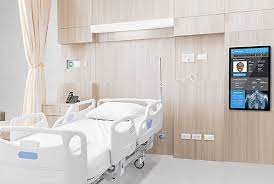
IoT in Healthcare

The Internet of Things (IoT) is being used in healthcare in a variety of ways to improve patient care and treatment. Some examples include:
- Remote monitoring of patients: Wearable devices, such as fitness trackers and smart watches, can be used to collect data on a patient's vital signs, such as heart rate and blood pressure, and transmit that data to healthcare providers for monitoring.
- Medication management: IoT-enabled pill bottles can remind patients when to take their medication, and can alert their healthcare provider if a dose is missed.
- Smart hospitals: IoT sensors can be used to monitor the environment in hospitals, such as air quality and temperature, to ensure that it is safe for patients and staff. Additionally, IoT-enabled medical equipment can be used to remotely monitor the health of patients and to alert staff to any potential issues.
- Telemedicine: IoT devices can facilitate virtual consultations between patients and healthcare providers, which can improve access to care and reduce the need for in-person visits.
- Clinical decision support: IoT device can Collect patient data and integrated with AI to analyze it in real time for clinical decision support, for example for remote monitoring chronic diseases such as diabetes, asthma, heart failure..
Overall, IoT has potential to improve healthcare delivery and improve the outcomes for patients. However, it is important to note that the security and privacy of patients' data need to be considered when implementing IoT in healthcare.
The Internet of Things (IoT) is being used in various stages of the patient journey to improve the overall experience and outcome. Some examples include:
- Pre-diagnosis: IoT devices such as wearable fitness trackers can be used to collect data on a patient's vital signs and activity levels, which can be used to identify potential health issues and provide early warnings of potential health concerns.
- Diagnosis: IoT-enabled medical devices can be used to collect data on a patient's health, such as blood pressure, heart rate, and oxygen levels, which can be used to diagnose conditions. Additionally, IoT devices can be used to conduct remote consultations, which can improve access to care and reduce the need for in-person visits.
- Treatment: IoT-enabled devices can be used to manage the administration of medication and to monitor the health of patients during treatment. Additionally, IoT-enabled medical equipment can be used to remotely monitor the health of patients and to alert healthcare providers to any potential issues.
- Post-treatment: IoT devices can be used to monitor the recovery of patients after treatment, such as by collecting data on vital signs and activity levels, which can be used to ensure that patients are healing properly and to identify any potential complications.
- Remote Monitoring: IoT devices can be used to remotely monitor the health of patients with chronic conditions, such as diabetes or heart failure, and to alert healthcare providers to any potential issues.
IoT has the potential to improve the patient journey by increasing access to care, providing more accurate and timely diagnoses, and improving the management of patients' conditions. However, it is important to consider the security and privacy of patients' data when implementing IoT in healthcare.